 W
WAnimal figurines are figurines that represent animals, either as decorative pieces, toys or collectibles. They are often made of plastic, ceramics, or metal.
 W
WArmy Men, or plastic soldiers, are toy soldiers that are about 5 cm (2.0 in) tall and most commonly molded from olive green, relatively unbreakable plastic. Unlike the more expensive toy soldiers available in hobby shops, army men are sold at low prices in discount stores and supermarkets in bulk packaging. Army men are sold unpainted and almost always dressed in modern military uniforms and armed with 20th-century weapons. 'Jumbo' Army Men are a less common secondary scale with 4.75" soldiers made with the same process.
 W
WAssault Lily is a Japanese mixed-media franchise created by Azone International and Acus. It mainly consists of two lines of toy figurines titled Assault Lily and Custom Lily. The series takes a theme of combining "girls" and "weapons" and revolves around teenagers girls called "Lilly" who have to fight against monsters called "Huge" using their weapon called "Charm." Two novels have been published; the first, titled Assault Lily: Ichiryūtai, Shutsugeki Shimasu! (アサルトリリィ~一柳隊、出撃します!~), was released in June 2015, and the second, titled Assault Lily Arms , was released in July 2017. Two stage plays based on the series have also been performed.
 W
WA doll is a model of a character, often used as a toy for young girls, and an artistic hobby for adults. Dolls have also been used in traditional religious rituals throughout the world. Traditional dolls made of materials such as clay and wood are found in the Americas, Asia, Africa and Europe. The earliest documented dolls go back to the ancient civilizations of Egypt, Greece, and Rome. They have been made as crude, rudimentary playthings as well as elaborate art. Modern doll manufacturing has its roots in Germany, from the 15th century. With industrialization and new materials such as porcelain and plastic, dolls were increasingly mass-produced. During the 20th century, dolls became increasingly popular as collectibles.
 W
WEntertainment Earth is an online retailer and wholesaler of licensed collectibles, including action figures, clothing, statues, prop replicas, games, vinyl figures, dolls, and toys.
 W
WThe figma (フィグマ) series is a Japanese action figure line produced by Max Factory and distributed by Good Smile Company. The product series is developed by the CEO of Max Factory, Max Watanabe, as well as Masaki Apsy, and focuses on creating highly articulated hand-sized figures with a focus on popular anime characters. Each figma is sold with various accessories such as exchangeable faces, hands and other optional parts. Occasionally figma figures are based on other subjects such as characters from the Japanese voice synthesizing software Vocaloid, to the popular Nintendo game series such as The Legend of Zelda and the Metroid series. A few figma figures are based on real people, such as a figma of Michael Jackson from his "Thriller" music video.
 W
WGogo's Crazy Bones are small, collectible figurines that became a popular fad during the late 1990s through the 2000s. They are produced by Spanish company Magic Box Int., and PPI Worldwide Group, the sole distributor in North America.
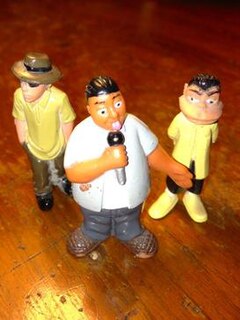 W
WHomies are a series of two-inch plastic collectible figurines representing various Chicano Mexican American characters. The line of toys was created by David Gonzales and based on a comic strip that Gonzales created featuring a cast of characters from his youth. Introduced in the year 1998, Homies were initially sold in grocery store vending machines and have become a highly collectible item, and have spawned many imitation toys.
 W
WKamisama Minarai: Himitsu no Cocotama is a Japanese anime television series animated by OLM, Inc., based on both the series of toys and Media Franchise created by Bandai Namco Holdings. The series focuses on Kokoro Yotsuba, a fifth grader who accidentally witness a small god born from her treasured color pencil set, and must be bound through a contract in order to keep his existence a secret. The series was directed by Norio Nitta and written by Michihiro Tsuchiya with character designs by Shinobu Ookawa. The series aired on all TXN stations in Japan on October 1, 2015 to June 28, 2018, replacing Tamagotchi! on its initial timeslot. The series uses a few elements from Shinto Animism, regarding the Cocotamas.
 W
WKira Kira Happy ★ Hirake! Cocotama is a Japanese anime television series animated by OLM, Inc. and a sequel to Kamisama Minarai: Himitsu no Cocotama, based on both the series of toys and Media Franchise created by Bandai Namco Holdings. The series was directed by Norio Nitta and written by Michihiro Tsuchiya with character designs by Shinobu Ookawa. The series aired on all TXN stations in Japan on September 6, 2018 to September 26, 2019, replacing Himitsu no Cocotama on its initial timeslot.
 W
WA model figure is a scale model representing a human, monster or other creature. Human figures may be either a generic figure of a type, a historical personage, or a fictional character.
 W
WMold-A-Rama is a brand name for a type of vending machine that makes injection molded plastic figurines. Mold-A-Rama machines debuted in late 1962 and grew in prominence at the 1964 New York World's Fair. The machines can still be found operating in dozens of museums and zoos.
 W
WMomiji [‘mom-ee-jee’] is a brand of collectible, hand-painted dolls inspired by Asian style and contemporary illustration. Each Momiji has a small space in the base to hide a secret message on a blank piece of folded card which is included with the doll. The dolls are a contemporary form of traditional Japanese Kokeshi dolls.
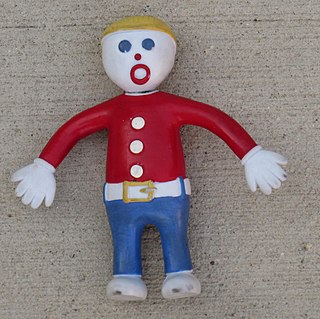 W
WMr. Bill is a clay figurine clown star of a parody of children's clay animation shows created by Walter Williams. "The Mr. Bill Show" got its start on Saturday Night Live as a series Super 8 film sent in response to the show's request for home movies during the first season. Mr. Bill's first appearance occurred on the February 28, 1976 episode. After five submitted films, Williams became a full-time writer for the show in 1978 and wrote more than 20 sketches based on Mr. Bill.
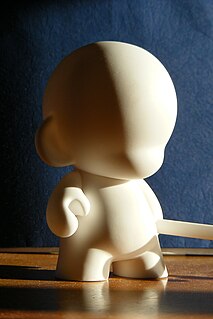 W
WA Munny is a toy from the American company Kidrobot.
 W
WThe Nendoroid series is a brand of plastic figures created by the Japanese Good Smile Company in 2006. They typically depict characters from anime, manga or video games and are designed with a large head and smaller body to give them a cute appearance. Their faces and other body parts are exchangeable, giving them a range of different expressions and poses. The Nendoroid brand spans a variety of different products: the original 10 cm figures, smaller Nendoroid Petite figures, additional display tools known as the Nendoroid More series as well as plushies and play sets. Several video games have also been released based on Nendoroid designs.
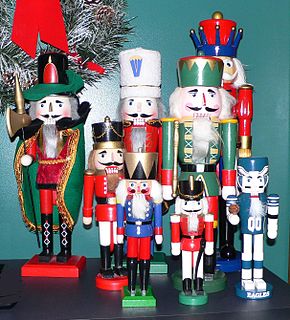 W
WNutcracker dolls, also known as Christmas nutcrackers, are decorative nutcracker figurines most commonly made to resemble a toy soldier. In German tradition, the dolls are symbols of good luck, frightening away malevolent spirits. While nearly all nutcrackers from before the first half of the 20th century are functional, a significant proportion of modern nutcrackers are primarily decorative, and not able to crack nuts. Nutcrackers are also a part of German folklore, serving as protectors of a house.
 W
WPenny toys is a name used for inexpensive tin toys mostly manufactured in Germany between the 1880s and 1914 that were sold in the UK, Europe and America in the late 19th century and early 20th century.
 W
WPinky:St, also written Pinky Street , are plastic (PET) figures designed by BabySue and manufactured by the Japanese company Vance Project. Their distinguishing feature is the interchangeable parts. The heads, hair styles, clothing and accessories can easily be switched between figures according to taste.
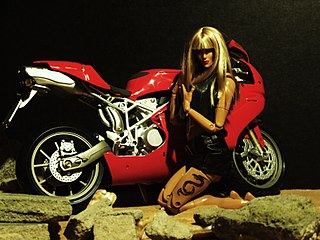 W
W1:6 scale modeling, also known as playscale miniaturism, is a hobby focusing on the collecting and/or customization of commercially produced 1:6 scale action figures and accessories.
 W
WA roly-poly toy, round-bottomed doll, tilting doll, tumbler or wobbly man is a round-bottomed toy, usually egg-shaped, that tends to right itself when pushed at an angle, and does this in seeming contradiction to how it should fall. The toy is typically hollow with a weight inside the bottom hemisphere. The placement of this weight is such that the toy has a center of mass below the center of the hemisphere, so that any tilting raises the center of mass. When such a toy is pushed over, it wobbles for a few moments while it seeks the upright orientation, which has an equilibrium at the minimum gravitational potential energy.
 W
WShopkins are a range of tiny, collectable toys, manufactured by Moose Toys. Based on grocery store items, each plastic figure has a recognisable face and unique name. They also have special finishes like translucent, glitter, or squishy. The collectable toys also have lines of clothing, trading cards, and other merchandise.
 W
WTin soldiers are miniature figures of toy soldiers that are very popular in the world of collecting. They can be bought finished or in a raw state to be hand-painted. They are generally made of pewter, tin, lead, other metals or plastic. Often very elaborate scale models of battle scenes, known as dioramas, are created for their display. Tin soldiers were originally almost two-dimensional figures, often called "little Eilerts" or "flats". They were the first toy soldiers to be mass-produced. Though largely superseded in popularity from the late 19th century by fully rounded three-dimensional lead figures, these flat tin soldiers continue to be produced.
 W
WA toy soldier is a miniature figurine that represents a soldier. The term applies to depictions of uniformed military personnel from all eras, and includes knights, cowboys, American Indians, pirates, samurai, and other subjects that involve combat-related themes. Toy soldiers vary from simple playthings to highly realistic and detailed models. The latter are of more recent development and are sometimes called model figures to distinguish them from traditional toy soldiers. Larger scale toys such as dolls and action figures may come in military uniforms, but they are not generally considered toy soldiers.
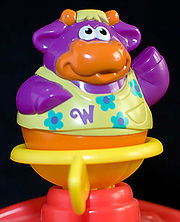 W
WWeebles is a range of children's roly-poly toys originating in Hasbro's Playskool division on July 23, 1971. Tipping an egg-shaped Weeble causes a weight located at the bottom-center to be lifted off the ground. Once released, gravity brings the Weeble back into an upright position. Weebles have been designed with a variety of shapes, including some designed to look like people or animals.